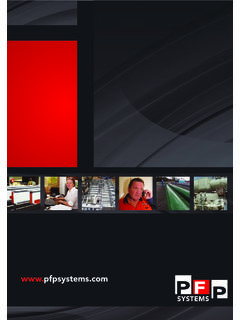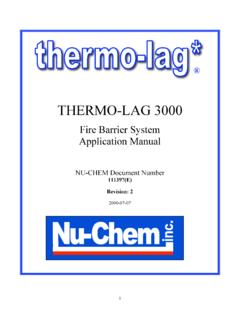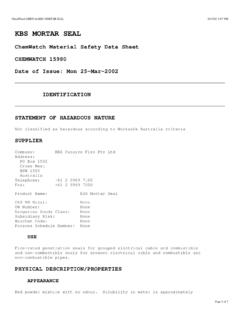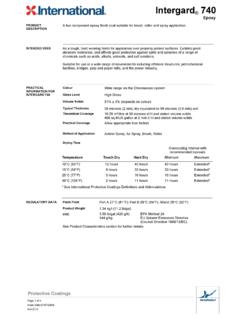Transcription of Interzone 954 - PFP Systems
1 A two component, low VOC, high solids, modified epoxy barrier coat designed to give long term protection in a single coat application. Will continue to cure when immersed in water and has excellent cathodic disbondment resistance. PRODUCT DESCRIPTIONP rimarily designed for use in offshore splashzone maintenance, where its continued cure under immersed conditions make it ideal for coping with tidal movements and surges. May be applied to reoxidised and slightly damp surfaces. Interzone 954 has also found extensive use in a number of other corrosive environments including pulp and paper plants, chemical plants, jetties and sluice gates.
2 As part of a non-slip deck system in conjunction with appropriate aggregate. INTENDED USESR ange available via the Chromascan system Gloss 85% 3% (depends on colour)250-500 microns (10-20 mils) dry equivalent to294-588 microns ( mils) m /litre at 500 microns and stated volume solids68 gallon at 20 mils and stated volume solids Allow appropriate loss factors Airless Spray, Air Spray, Brush, Roller PRACTICAL INFORMATION FOR Interzone 954 ColourGloss LevelVolume SolidsTypical ThicknessTheoretical CoveragePractical CoverageMethod of ApplicationDrying TimeTemperature Touch DryHard DryMinimumMaximum Maximum overcoating intervals are shorter when using polysiloxane topcoats.
3 Consult International Protective Coatings for further Interval withrecommended topcoats10 C (50 F) 14 hours24 hours24 hours14 days 15 C (59 F) 10 hours18 hours18 hours10 days 25 C (77 F) 4 hours8 hours8 hours7 days 40 C (104 F) 90 minutes3 hours3 hours5 days Base (Part A)30 C (86 F)C/A (Part B)44 C (111 F)Mixed33 C (91 F) kg/l ( lb/gal) REGULATORY DATAF lash PointProduct WeightVOCSee Product Characteristics section for further details130 g/l ( lb/gal) UK - PG6/23(04), Appendix 3 lb/gal (255 g/l) USA - EPA Method 24249 g/l, 162 g/kg EU Solvent Emissions Directive(Council Directive 1999/13/EC) Interzone 954M o d i f i e d E p o x yPage 1 of 4 Interzone 954 Modified EpoxyThe performance of this product will depend upon the degree of surface preparation.
4 The surface to be coated must be clean and free from contamination. Prior to paint application all surfaces should be assessed and treated in accordance with ISO 8504:2000. Accumulated dirt and soluble salts must be removed. Dry bristle brushing will normally be adequate for accumulated dirt. Soluble salts should be removed by fresh water washing. Oil or grease should be removed in accordance with SSPC-SP1 solvent cleaning. Abrasive Blast Cleaning Abrasive blast clean to Sa2 (ISO 8501-1:1988) or SSPC-SP6. If oxidation has occurred between blasting and application of Interzone 954, the surface should be reblasted to the specified visual standard.
5 Surface defects revealed by the blast cleaning process, should be ground, filled, or treated in the appropriate manner. A surface profile of 50-75 microns (2-3 mils) is recommended. Ultra High Pressure Hydroblasting / Abrasive Wet Blasting May be applied to surfaces prepared to Sa2 (ISO 8501-1:1988) or SSPC-SP6 which have flash rusted to no worse than Grade HB2 M (refer to International Hydroblasting Standards). It is also possible to apply to damp surfaces in some circumstances. Further information is available from International Protective Coatings. Aged Coatings Interzone 954 is suitable for overcoating some sound intact aged coatings.
6 To ensure compatibility, application and evaluation of a test patch is PREPARATIONM aterial is supplied in two containers as a unit. Always mix a complete unit in the proportions supplied. Once the unit has been mixed it must be used within the working pot life specified.(1) Agitate Base (Part A) with a power agitator.(2) Combine entire contents of Curing Agent (Part B) with Base(Part A) and mix thoroughly with power agitator. 4 part(s) : 1 part(s) by volume SuitableTypically 100-150 microns ( mils) can be achievedSuitableTypically 75-125 microns ( mils) can be achieved International GTA220(or International GTA415) International GTA822or International GTA415 Do not allow material to remain in hoses, gun or spray equipment.
7 Thoroughly flush all equipment with International GTA822. Once units of paint have been mixed they should not be resealed and it is advised that after prolonged stoppages work recommences with freshly mixed all equipment immediately after use with International GTA822. It is good working practice to periodically flush out spray equipment during the course of the working day. Frequency of cleaning will depend upon amount sprayed, temperature and elapsed time, including any delays. All surplus materials and empty containers should be disposed of in accordance with appropriate regional not thin more than allowed by local environmental legislationRecommendedRecommendedGun DeVilbiss MBC or JGAAir Cap 62 Fluid Tip ACTip Range mm (21-26 thou)Total output fluid pressure at spray tip not less than 176 kg/cm (2503 )APPLICATIONM ixingMix RatioWorking Pot LifeAirless SprayAir Spray(Pressure Pot)BrushRollerThinnerCleanerWork StoppagesClean Up10 C (50 F) 15 C (59 F) 25 C (77 F) 40 C (104 F)
8 3 hours2 hours90 minutes45 minutesPage 2 of 4 Interzone 954 Modified EpoxyMaximum film build in one coat is best attained by airless spray. When applying by methods other than airless spray, the required film build is unlikely to be achieved. Application by air spray may require a multiple cross spray pattern to attain maximum film build. Low or high temperatures may require specific application techniques to achieve maximum film build. When applying Interzone 954 by brush or roller, it may be necessary to apply multiple coats to achieve the total specified system dry film thickness.
9 Surface temperature must always be a minimum of 3 C (5 F) above dew point. Do not apply at steel temperatures below 4 C (39 F). When applying Interzone 954 in confined spaces ensure adequate ventilation. In special cases where overcoating is required and curing has been at low temperatures and high relative humidities, ensure no amine bloom is present prior to application of subsequent topcoats. Condensation occurring during or immediately after application may result in a matt finish and an inferior film. Premature exposure to ponding water will cause a colour change, especially in dark colours.
10 In common with all epoxies Interzone 954 will chalk and discolour on exterior exposure. However, these phenomena are not detrimental to anti-corrosive performance. Where a durable cosmetic finish with good gloss and colour retention is required overcoat with recommended topcoats. When applied between tides on jetties, piling etc., Interzone 954 can be immersed within 30 minutes. This will lead to whitening of dark colours but will not affect ultimate anti-corrosive performance. For use in atmospheric service a minimum dry film thickness of 350 microns (14 mils) is required in one coat when applied direct to steel, for water immersion a minimum of 450 microns (18 mils) dry film thickness is recommended.











